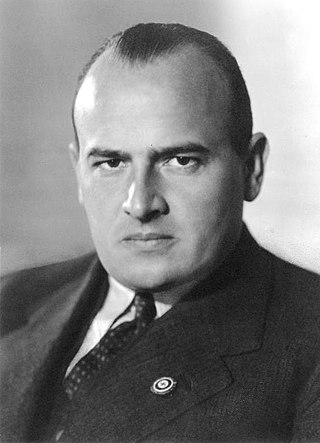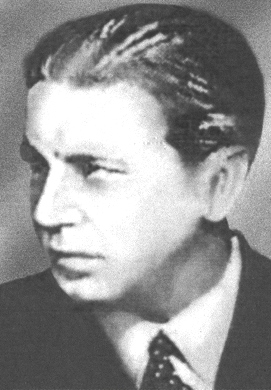Related Research Articles

Hans Michael Frank was a German politician, war criminal and lawyer who served as head of the General Government in German-occupied Poland during the Second World War.

The Nuremberg rallies were a series of celebratory events coordinated by the Nazi Party in Germany. The first Nazi Nuremberg rally took place in 1923. This rally was not particularly large and did not have much impact; however, as the party grew in size, the rallies became more elaborate and featured larger crowds. They played a seminal role in Nazi propaganda events, conveying a unified and strong Germany under Nazi control. The rallies became a national event once Adolf Hitler rose to power in 1933, when they became annual occurrences. Once the Nazi dictatorship was firmly established, the party's propagandists began filming them for a national and international audience. Nazi filmmaker Leni Riefenstahl produced some of her best known work including Triumph of the Will (1934) and The Victory of Faith (1933), both filmed at the Nazi party rally grounds near Nuremberg. The party's 1938 Nuremberg rally celebrated the Anschluss that occurred earlier that year. The 1939 scheduled rally never came to pass and the Nazi regime never held another one as both the government and Nazi Party prioritized Germany's effort in the Second World War over everything else.

Johannes Albrecht Blaskowitz was a German Generaloberst during World War II. He was a recipient of the Knight's Cross of the Iron Cross with Oak Leaves and Swords. After joining the Imperial German Army in 1901, Blaskowitz served throughout World War I, where he earned an Iron Cross for bravery.

Ernst Klee was a German journalist and author. As a writer on Germany's history, he was best known for his exposure and documentation of medical crimes in Nazi Germany, much of which was concerned with the Action T4 or involuntary euthanasia program. He is the author of "The Good Old Days": The Holocaust Through the Eyes of the Perpetrators and Bystanders first published in the English translation in 1991.

Albrecht Georg Haushofer was a German geographer, diplomat, author and member of the German Resistance to Nazism.

Otto Lebrecht Eduard Daniel Meissner was head of the Office of the President of Germany from 1920 to 1945 during nearly the entire period of the Weimar Republic under Friedrich Ebert and Paul von Hindenburg and, finally, under the Nazi government under Adolf Hitler.

Rudolf "Dolf" von Scheliha was a German aristocrat, cavalry officer and diplomat who became a resistance fighter and anti-Nazi who was linked to the Red Orchestra.

Der Sieg des Glaubens is the first Nazi propaganda film directed by Leni Riefenstahl. Her film recounts the Fifth Party Rally of the Nazi Party, which occurred in Nuremberg, Germany, from 30 August to 3 September 1933. The film is of great historic interest because it shows Adolf Hitler and Ernst Röhm on close and intimate terms, before Hitler had Röhm killed during the Night of the Long Knives on 1 July 1934. As he then sought to remove Röhm from German history, Hitler ordered all known copies of the film be destroyed, and it was considered lost until a surviving copy was found in the 1980s in East Germany.

Untermensch is a German language word literally meaning 'underman', 'sub-man', or 'subhuman', that was extensively used by Germany's Nazi Party to refer to non-Aryan people they deemed as inferior. It was mainly used against "the masses from the East", that is Jews, Roma, and Slavs.

Honorary Aryan was a semi-official category and expression used in Nazi Germany to justify the exceptional awarding of Aryan certificates to some regime-favoured Mischlinge who according to Nuremberg Laws standards would not have been recognized as belonging to the Aryan race, but whom German officials nevertheless chose to spare persecution.

Extermination through labour is a term that was adopted to describe forced labor in Nazi concentration camps whose inmates were held in inhumane conditions and suffered a high mortality rate; in some camps most prisoners died within a few months of incarceration. In the 21st century, research has questioned whether there was a general policy of extermination through labor in the Nazi concentration camp system because of widely varying conditions between camps. German historian Jens-Christian Wagner argues that the camp system involved the exploitation of forced labor of some prisoners and the systematic murder of others, especially Jews, with only limited overlap between these two groups.

Axel Ernst-August Clamor Franz Albrecht Erich Leo Freiherr von dem Bussche-Streithorst was a German officer during World War II and was a member of the German Resistance. He planned to assassinate Adolf Hitler in coordination with Claus von Stauffenberg in November 1943 at the Wolfsschanze.

Heinz Peter Longerich is a German professor of history and historian. He is regarded by Ian Kershaw, Richard Evans, Timothy Snyder, Mark Roseman and Richard Overy, as one of the leading German authorities on the Holocaust.
Gerd Schultze-Rhonhof is a German author and former Generalmajor in the German Army of the Bundeswehr, who, like Udo Walendy, also disputes Germany's sole guilt for the Second World War.
Degeto Weltspiegel were short Nazi propaganda/news films that played in German cinemas from 1939 to 1943. There were a total of 50 reels. They were produced by Tobis Film on 35 mm film by special units within the German Army. The following list is not complete. Below are other specials within a certain theme.
- Spanien und der 50. Geburtstag des Führers
- Der Stählerne Pakt wird unterzeichnet
- Danzig, Italien und Japan
- Der Westwall
- Danzig ist wieder deutsch
- Führerhauptquartier
- Warschau kapituliert
- Deutsche Schiffe kontrollieren die See
- Dänemark und Norwegen unter Deutschem Schutz
- Vormarsch in Norwegen
- Im Morgengrauen des 10. Mai 1940
- Vorwärts durch Belgien
- Aus der deutschen Seekriegsführung
- Marz durch Belgien
- Die Schlacht um Dunkirchen
- Rheinübergang und Eroberung der Marginot Linie
- Die Schlacht von Frankreich
- Der Einzug in Paris
- Zweimal Waffenstillstand
- Entscheidung auf dem Balkan I. Englands Balkanplane
- Entscheidung auf dem Balkan II. Jugoslawiens Ende
- Entscheidung auf dem Balkan III. Der Sprung nach Kreta
- Europas Kampf gegen den Bolschewismus I,
- Europas Kampf gegen den Bolschewismus II, Ein Erdteil marschiert
- Europas Kampf gegen den Bolschewismus III, Kampf um Finnland
- Europas Kampf gegen den Bolschewismus IV, Sowjetrussland; Stalin-Linie
- Europas Kampf gegen den Bolschewismus V, Aus dem Führerhauptquartier, 19. Sept. 1941
- General Rommel und die Panzerarmee Afrika
- Deutsche Schlachtschiffe brechen durch den Kanal
- Winterkrieg 1941/1942 im Osten
- Eroberung von Kertsch
- Die Schlacht bei Charkow
- Tobruk Fallt – 21. Juni 1942
- Kampf um Sewasatopol
- Einnahme Sewastopol, die stärkste Festung der Welt
- Vernichtung des Britisch-Amerikanischen Geleitzuges
- Kämpfe zwischen Donez und Don
- Sturm auf Rostow
- Luftangriffe auf Malta und Kämpfe an der El Alamein Front
- Sturm auf Armawyr und Woroschilowsky
- Dieppe 19. Aug. 1942
- Kaukasusfront (Elbrusbesteigung)
- Kampf um Stalingrad
- Von Murmansk bis Afrika
- Luftangriffe im Osten
- Heldengedenktag März 1943

Karl Richard Freiherr Michel von Tüßling was a German Schutzstaffel (SS) officer who served in the Nazi government of dictator Adolf Hitler, in the staff of the Reichsführer SS and in the staff of the SS Main Office. From 1936 onwards, he also was the personal adjutant of Reichsleiter and SS-Obergruppenführer Philipp Bouhler, who was in charge of Hitler's Chancellery, head of the euthanasia programme Aktion T4, as well as co-initiator of Aktion 14f13. In 1947 Tüßling provided an affidavit in defence of war criminal Viktor Brack who was sentenced to death at the Nuremberg trials.
A war of annihilation or war of extermination is a type of war in which the goal is the complete annihilation of a state, a people or an ethnic minority through genocide or through the destruction of their livelihood. The goal can be outward-directed or inward, against elements of one's own population. The goal is not like other types of warfare, the recognition of limited political goals, such as recognition of a legal status, control of disputed territory, or the total military defeat of an enemy state.
At the conclusion of his Obersalzberg Speech on 22 August 1939, a week before the German invasion of Poland, Nazi leader Adolf Hitler reportedly said "Who, after all, speaks today of the annihilation of the Armenians?".

During World War I, Germany was a military ally of the Ottoman Empire, which perpetrated the Armenian genocide. Many Germans present in eastern and southern Anatolia witnessed the genocide, but censorship and self-censorship hampered these reports, while German newspapers reported Ottoman denials of the genocide. Approximately 800 officers and 25,000 soldiers of the Imperial German Army were sent to the Middle Eastern theatre of World War I to fight alongside the Ottoman Army, with German commanders serving in the Ottoman high command and general staff. It is known that individual German military advisors signed some of the orders that led to Ottoman deportations of Armenians, a major component of the genocide.
References
- ↑ Dadrian, Vahakn (2003). The History of the Armenian Genocide: Ethnic Conflict from the Balkans to Anatolia to the Caucasus. Berghahn Books. p. 408. ISBN 1571816666.
- 1 2 von Klemperer, Klemens The German Resistance Against Hitler: The Search for Allies Abroad, 1938–1945, Oxford: Oxford University Press, 1993 p. 133.
- ↑ British Foreign Office, Documents on British Foreign Policy, 1919–1939, Great Britain Foreign Office, p. 257.
- ↑ Marrus, Michael The Holocaust In History, Hanover: Brandeis University Press, 1987 pp. 20–21.
- ↑ "Translation of doc 1014-PS"http://library2.lawschool.cornell.edu/donovan/pdf/Batch_2_pdfs/Vol_IV_8_06.pdf
- ↑ "Translation of doc 780-ps"http://library2.lawschool.cornell.edu/donovan/pdf/Batch_2_pdfs/Vol_IV_8_05.pdf
- 1 2 3 4 "IMG Nürnberg 1014-ps" http://upload.wikimedia.org/wikipedia/commons/1/1b/A-Hitler-08-22-1939-at-Obersalzberg-on-planned-attack-on-Poland-and-extermination-of-Poles.pdf
- ↑ "L-3 is inside the footnote of the document"http://library.fes.de/library/netzquelle/zwangsmigration/32ansprache.html
- ↑ Albrecht, Richard (2007). Crime/s against mankind, humanity and civilisation (1. Aufl. ed.). München: Grin Verlag. p. 65. ISBN 978-3638888639.
- 1 2 "One Hundred and Thirty-Second Day Friday, 17 May 1946 page 64 " http://avalon.law.yale.edu/imt/05-17-46.asp
- ↑ One Hundred and Thirty-First Day Thursday, 16 May 1946 page 47"http://avalon.law.yale.edu/imt/05-16-46.asp
- ↑ "Portrayals of Hitler Project" http://www.history.ucsb.edu/faculty/marcuse/projects/hitler/hitler.htm
- ↑ Reisman, Arnold, Could the US Holocaust Memorial Museum Have Erred in a Major Exhibit? (31 December 2010). p. 18. Available at SSRN:
- ↑ In his scholarly essay published in 2008, the German researcher Dr. Richard Albrecht discussed all five versions of Hitler's second secret speech delivered to his High Commanders on 22 August 1939, at Obersalzberg and republished the first German version of the fifth which later on was named the Lochner- (or L-3-) version, at first published in the German journal in exile, "Deutsche Blätter. Für ein europäisches Deutschland / Gegen ein deutsches Europa" [Santiago de Chile], 2 (1944) 3, 37–39; see Richard Albrecht, "Wer redet heute noch von der Vernichtung der Armenier?" – Kommentierte Wiederveröffentlichung der Erstpublikation von Adolf Hitlers Geheimrede am 22. August 1939; in: Zeitschrift für Weltgeschichte, 9 (2008) 2: 115–132
- ↑ Office of the United States Chief of Counsel for Prosecution of Axis Criminality (1946). "Chapter IX – Launching of wars of aggression". Nazi Conspiracy and Aggression. Vol. 1.
- ↑ Lochner, Louis Paul (1942). What About Germany?. Dodd, Mead & Company. pp. 11–12.
- ↑ As included in a footnote in the Akten zur deutschen auswärtigen Politik (ser. D, vol. 7, 1961, p. 193).